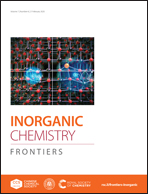Improved polaronic transport under a strong Mott–Hubbard interaction in Cu-substituted NiO†
Abstract
The origin of the electrical and optical properties of Cu-substituted NiO (Cu : NiO) polycrystalline bulks synthesized via a solid-state reaction is reported. The partial substitution of Ni sites with Cu led to a drastic decrease of the electrical resistivity from 7.73 × 108 to 6.51 × 104 Ω·cm and a reduction in the energy for the self-trapping barrier from 0.58 to 0.24 eV in accordance with small polaron hopping conduction. The well-sustained band gap of 3.1 eV and antiferromagnetic transition temperature of 453 K demonstrate that the strength of the electron correlation in NiO can persist even at a high Cu concentration up to 22 atomic percent. Density functional theory calculations confirm that the Cu 3d orbital encourages d–p hybridization between metal cations and oxygen anions at the valence band maximum. As a consequence, this hybridization plays a critical role in improving the polaron hopping efficiency without much suppression of the Mott–Hubbard interaction and thus retaining the wide band gap nature.



 Please wait while we load your content...
Please wait while we load your content...